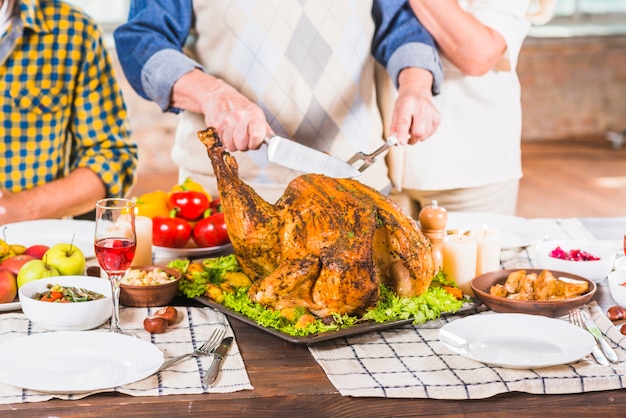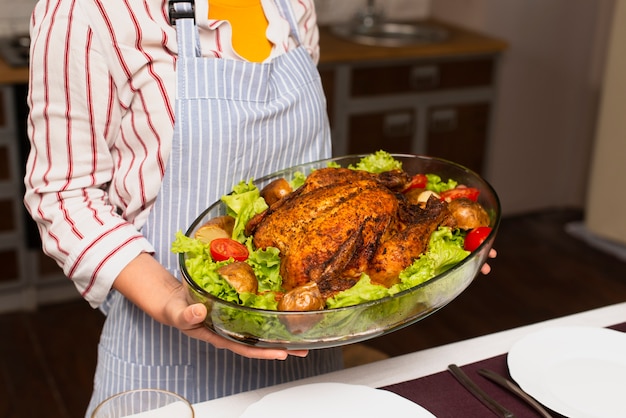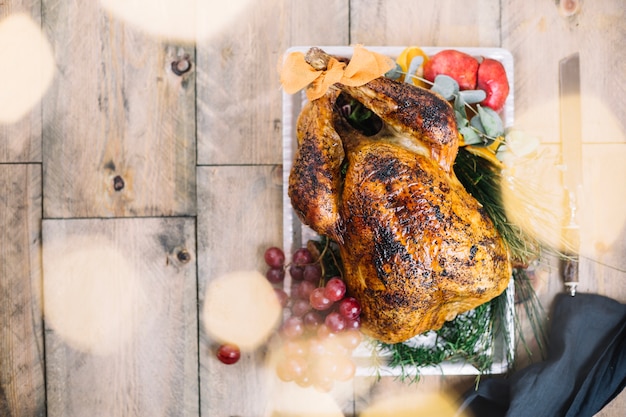Let's face it, tackling a 15 lb turkey is a bit like facing down a culinary dragon. But fear not, dear reader! With a little know-how and a dash of confidence, you'll be carving up a masterpiece in no time. This guide isn't just about cooking a turkey; it's about conquering it. We're going to delve into every aspect, from choosing the perfect bird to tackling those inevitable leftovers. Ready? Let's get cooking!
Part 1: The Turkey Selection

First things first, you need a turkey. A 15 lb bird is no small feat, so choosing the right one is crucial. Should you go fresh or frozen? Honestly, both have their merits. I'm a sucker for fresh, but a frozen turkey is a perfectly viable option. Just remember, you'll need to give it plenty of time to thaw out.
Fresh or Frozen: A Decision You Can Make
Fresh turkeys often have a more vibrant flavour and are easier to handle since there's no defrosting involved. However, they're often pricier. Frozen turkeys are readily available and much more budget-friendly, especially if you plan ahead. Just make sure to thaw it properly - you don't want to be dealing with a half-frozen beast in the middle of your cooking marathon!
Spotting a Great Turkey: A Quick Checklist
When you're selecting your bird, have a good look at it. The skin should be smooth and free from any blemishes or odd colourations. The breast should be plump and firm, not too soft or squishy. Give it a gentle squeeze - a good turkey will spring back. If you're not sure, don't hesitate to ask the butcher for advice. They're usually more than happy to help you pick the perfect specimen. And remember, always check the expiry date!
Part 2: Preparing for the Big Day

You've got your turkey, now it's time to get organised. This is a bit like prepping for a battle, and you wouldn't go into a fight unprepared, would you?
Planning the Feast: Beyond the Turkey
First, consider your menu. What sides will accompany your majestic turkey? Stuffing, mashed potatoes, gravy, cranberry sauce, vegetables – the possibilities are endless! I like to keep things manageable and choose a few simple dishes that complement the turkey without overshadowing it. Don't be afraid to experiment and find what works best for you. A simple side dish that always wins me over is a classic green bean casserole.
Prepping Your Turkey: A Night Before Ritual
The night before, give your turkey a good wash inside and out, pat it dry with paper towels, and then generously season with salt and pepper. Feel free to add a few herbs and spices, but remember, the turkey is the star of the show! You can also add butter to the cavity for extra richness, or even stuff it with herbs and bread. I find a few chopped onions and carrots in the cavity add a delightful flavour to the bird and create an amazing base for gravy later.
Brining: A Secret Weapon for a Juicy Bird
Now, let's talk about brining. You might be thinking, "What exactly is brining?" In a nutshell, it's a magic trick that infuses your turkey with moisture and flavour. It's simple: you soak the turkey in a saltwater solution for a few hours or overnight. You can add herbs and spices to your brine, which is a fantastic way to ensure a juicy, flavour-packed turkey. I prefer a simple brine with salt, water, and a few herbs, but feel free to experiment. There are loads of recipes online if you want to get fancy!
Part 3: The Big Cook-Off

This is the moment of truth. The big day has arrived, and it's time to cook your magnificent bird!
The oven method: A Classic with a Twist
You can cook your turkey in the oven or in a roasting bag, but I'm a big fan of the classic oven method. Preheat your oven to about 350°F (175°C). Place your turkey in a roasting pan and add a little water to the bottom to create steam and prevent the turkey from drying out. Adding a few onions and carrots to the bottom of the pan will give you a delicious base for gravy later.
cooking time and Temperature: The Key to Success
Now, let's talk about the important stuff: cooking time. The rule of thumb is about 15 minutes per pound at 350°F, but this can vary depending on the size and shape of your bird. Always check the temperature using a meat thermometer. The turkey is fully cooked when the internal temperature reaches 165°F (74°C) in the thickest part of the thigh.
Part 4: Rest and Relaxation for Your Turkey
Once your turkey is cooked, you need to let it rest for about 30 minutes before you carve it. This is crucial. It allows the juices to redistribute throughout the meat, making it incredibly tender and flavourful. Cover the turkey with foil while it rests, this will keep it warm and moist.
The Art of Carving: A Culinary Ballet
Now, the grand finale: carving. This is where your inner culinary artist shines. You'll need a sharp carving knife, and the key is to slice the turkey across the grain, this prevents the meat from falling apart. Start by carving the breast meat, then the legs and thighs. If you're feeling adventurous, you can even try carving the wings.
Part 5: The Importance of Your Culinary Ally: The Meat Thermometer
Don't underestimate the importance of a meat thermometer. It's your lifeline in this whole turkey-cooking saga. It tells you whether your turkey is cooked through, saving you from potential foodborne illness. Insert the thermometer into the thickest part of the thigh, making sure it doesn't touch any bone. If you're using a digital thermometer, wait for the temperature to stabilize. It's a good idea to check the temperature in a few different spots to ensure the turkey is cooked evenly.
Saving a Dry Turkey: A Culinary Rescue Mission
Let's face it, even the best intentions can lead to a slightly dry turkey. Don't panic! There are a few tricks up our sleeves. First, make sure you let the turkey rest for at least 30 minutes before carving. This allows the juices to redistribute. If your turkey is still a bit dry, add some gravy or sauce while serving. However, remember, even a slightly dry turkey is better than an undercooked one.
Part 6: side dishes to Elevate Your Feast
No turkey dinner is complete without some amazing sides!
Classic Comforts: The Staples of a Festive Feast
You can't go wrong with the classics: mashed potatoes, stuffing, gravy, and cranberry sauce. These dishes are the heart of a traditional turkey dinner for a reason. They're delicious and easy to make. For mashed potatoes, I like to add a bit of butter, milk, and cream. A dash of herbs and spices is always a nice touch. For stuffing, I use bread cubes, onions, celery, and herbs. Remember to cook the stuffing separately from the turkey for safety. For the gravy, make a simple roux with butter and flour, then add some turkey broth and cook until thickened. For cranberry sauce, you can make it from scratch or grab a jar – no judgment here!
Beyond the Classics: Exploring New Flavours
Let's get creative with those side dishes! There are so many delicious options that would perfectly complement your turkey.
- Roasted root vegetables: Roast carrots, parsnips, and sweet potatoes for a vibrant and healthy side dish.
- Green bean casserole: A classic side dish that never fails to impress.
- Brussel sprouts with bacon: Roast Brussel sprouts with crispy bacon for a delicious and salty side.
- Cornbread: A simple cornbread adds a touch of sweetness to your meal.
Tips for Side Dish Perfection
When making your side dishes, it's important to cook them thoroughly and season them well. Don't be afraid to experiment with flavours and spices! And make sure you cook your sides to the right temperature. You don't want to serve anything undercooked or overcooked.
Part 7: Leftover Love: The Art of Making More Meals
Your turkey is cooked, the sides are devoured, and you've had your fill. But what about those leftovers? Don't let them go to waste! There's a whole world of delicious possibilities waiting to be discovered.
turkey sandwiches: A Classic Comfort
The ultimate leftover turkey dish is a classic turkey sandwich. Use white or brown bread, add lettuce, tomato, mayonnaise, and maybe even a touch of cranberry sauce or stuffing for a bit of extra flavour. I like to toast mine for a crispy crunch.
turkey soup: Warming Comfort in a Bowl
A hearty turkey soup is another great way to use up leftover turkey. Add vegetables, noodles, or rice, and a bit of cream for a luxurious touch.
turkey pot pie: A Hearty and Delicious Leftover Transformation
For a more substantial meal, make a delicious turkey pot pie. This is a great way to use up any leftover vegetables and gravy. You can use store-bought pie crust or make your own.
turkey salad: A Light and Refreshing Option
Turkey salad is a light and refreshing way to enjoy leftover turkey. Add celery, onions, and mayonnaise. You can also add cranberries or walnuts for a bit of extra flavour. It's great served on bread or crackers.
Part 8: FAQs: Answering Your Turkey Queries
You've got questions, and I've got answers.
1. Can I Stuff the Turkey with Raw Stuffing?
I'm going to be honest, I'm a firm believer in cooking the stuffing separately. It's safer, and it makes it much easier to ensure the stuffing is cooked through. Plus, it leaves the turkey cavity free for those delicious juices! You can also stuff the turkey with herbs and vegetables, like onions and carrots, for added flavour. But if you're adamant about stuffing the turkey, make sure you cook the stuffing thoroughly until it reaches an internal temperature of 165°F (74°C).
2. What Happens if the Turkey is Undercooked?
An undercooked turkey is a culinary crime. It can be dangerous to eat, so always check the temperature with a meat thermometer. If your turkey isn't cooked through, you'll need to cook it longer. And if you're ever unsure, it's best to err on the side of caution and cook it for a few extra minutes.
3. What if the Turkey is Dry?
We've already touched on this, but don't worry, there are ways to rescue a dry turkey. Letting it rest before carving is crucial. You can also add some gravy or sauce while serving. But, as always, remember a slightly dry turkey is better than an undercooked one.
4. Can I Freeze Leftover Turkey?
Yes, you can freeze leftover turkey. It's best to freeze it in airtight containers or freezer bags. It should last for about 2-3 months in the freezer. When you're ready to use it, defrost it in the refrigerator overnight.
5. How Long Can I Keep Cooked Turkey in the Fridge?
Cooked turkey can be stored in the fridge for about 3-4 days. Make sure you store it in an airtight container or wrap it tightly in plastic wrap. After that, it's best to freeze it.
Part 9: Final Thoughts: A Culinary Victory
There you have it, the ultimate guide to conquering a 15 lb turkey. It might seem like a daunting task, but with a little planning and a dash of confidence, you'll be carving up a masterpiece in no time. Remember, it's all about the journey, not just the destination. So, relax, enjoy the process, and most importantly, have fun!
Everyone is watching

Corn on the Cob: The Ultimate Guide to Perfectly Cooked Ears
Healthy MealsAh, corn on the cob. Just the name evokes images of sunny days, barbecues, and that sweet, juicy flavour that ...

Perfect Pork Roast Oven Cooking Time: A Guide to Delicious Results
Healthy MealsThere's something truly satisfying about a perfectly roasted pork. The aroma alone is enough to make your mout...

Ham Cooking Time: How Long to Bake, Smoke, or Boil a Delicious Ham
Healthy MealsAh, ham. It's a classic, isn't it? A real crowd-pleaser, especially around holidays. And when done right, it'...

Scallops: The Ultimate Guide to Perfect Cooking
Healthy MealsAh, scallops. Those delicate, sweet, and utterly delicious morsels of the sea. They hold a special place in my...

Spaghetti Squash: The Ultimate Guide to Cooking and Serving
Healthy MealsRemember that time you saw spaghetti squash at the supermarket, looking all bumpy and strange, and thought, "W...
